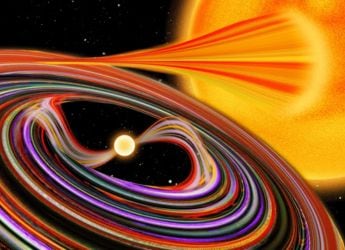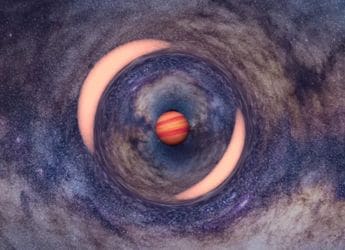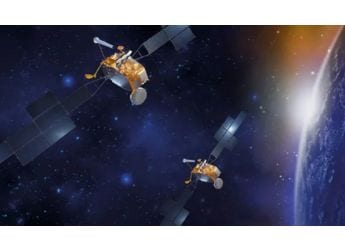- Home
- Science
- Science News
- Nasa Reveals the Fact and Fiction of Martian Dust Storms
Nasa Reveals the Fact and Fiction of Martian Dust Storms

Beyond Mars' large annual storms are massive storms that occur more rarely but are much larger and more intense.
"Every year, there are some moderately big dust storms that pop up on Mars and they cover continent-sized areas and last for weeks at a time," said Michael Smith, planetary scientist at Nasa's Goddard Space Flight Center in Greenbelt, Maryland.
"Once every three Mars years (about five-and-a-half Earth years), on average, normal storms grow into planet-encircling dust storms, and we usually call those 'global dust storms' to distinguish them," Smith noted in a statement.
However, it is unlikely that even these dust storms could strand an astronaut on Mars.
The winds in the largest dust storms were unlikely to tip over or rip apart major mechanical equipment.
The winds in the strongest Martian storms top out at about 60 miles per hour, less than half the speed of some hurricane-force winds on Earth.
Focusing on wind speed may be a little misleading as well. The atmosphere on Mars is about one percent as dense as Earth's atmosphere.
"That means to fly a kite on Mars, the wind would need to blow much faster than on Earth to get the kite in the air," Smith added.
Scheduled for worldwide release on October 2, "The Martian" is based on a 2011 best-selling novel by former computer programmer Andy Weir.
The film begins with a massive dust storm that strands fictional astronaut Mark Watney (Matt Damon) on Mars.
In the scene, a powerful wind rips an antenna out of a piece of equipment and destroys parts of the astronauts' camp.
For years, science fiction writers from Edgar Rice Burroughs to C.S. Lewis have imagined what it would be like for humans to walk on Mars.
As mankind comes closer to taking its first steps on the Red Planet, authors' depictions of the experience have become more realistic.
"The key difference between Earth and Mars is that Mars' atmospheric pressure is a lot less. So things get blown, but it is not with the same intensity," explained William Farrell, plasma physicist who studies atmospheric breakdown in Mars dust storms at Goddard.
Mars' dust storms are not totally innocuous, however.
Individual dust particles on Mars are very small and slightly electrostatic so they stick to the surfaces they contact.
"If you have seen pictures of Curiosity after driving, it is just filthy. The dust coats everything and it is gritty. It gets into mechanical things that move, like gears," Smith informed.
In "The Martian," Watney spends part of every day sweeping dust off his solar panels to ensure maximum efficiency, which could represent a real challenge faced by future astronauts on Mars.
When faced with a larger dust storm in the book, Watney's first hint is the decreased efficiency of his solar panels, caused by a slight darkening of the atmosphere.
"That's a pretty accurate depiction of what large dust storms can do," Smith said.
Scientists have been tracking global dust storms on Mars for more than a century, using both telescopes on Earth and spacecraft orbiting Mars.
Catch the latest from the Consumer Electronics Show on Gadgets 360, at our CES 2026 hub.
Related Stories
- Samsung Galaxy Unpacked 2025
- ChatGPT
- Redmi Note 14 Pro+
- iPhone 16
- Apple Vision Pro
- Oneplus 12
- OnePlus Nord CE 3 Lite 5G
- iPhone 13
- Xiaomi 14 Pro
- Oppo Find N3
- Tecno Spark Go (2023)
- Realme V30
- Best Phones Under 25000
- Samsung Galaxy S24 Series
- Cryptocurrency
- iQoo 12
- Samsung Galaxy S24 Ultra
- Giottus
- Samsung Galaxy Z Flip 5
- Apple 'Scary Fast'
- Housefull 5
- GoPro Hero 12 Black Review
- Invincible Season 2
- JioGlass
- HD Ready TV
- Laptop Under 50000
- Smartwatch Under 10000
- Latest Mobile Phones
- Compare Phones
- Motorola Signature
- Vivo Y50e 5G
- Vivo Y50s 5G
- Realme 16 Pro+ 5G
- Realme 16 Pro 5G
- TCL Nxtpaper 70 Pro
- OPPO A6 Pro 5G
- Honor Power 2
- Lenovo Yoga Slim 7x (2025)
- Lenovo Yoga Slim 7a
- Realme Pad 3
- OPPO Pad Air 5
- Xiaomi Watch 5
- Huawei Watch 10th Anniversary Edition
- Acerpure Nitro Z Series 100-inch QLED TV
- Samsung 43 Inch LED Ultra HD (4K) Smart TV (UA43UE81AFULXL)
- Asus ROG Ally
- Nintendo Switch Lite
- Haier 1.6 Ton 5 Star Inverter Split AC (HSU19G-MZAID5BN-INV)
- Haier 1.6 Ton 5 Star Inverter Split AC (HSU19G-MZAIM5BN-INV)

















